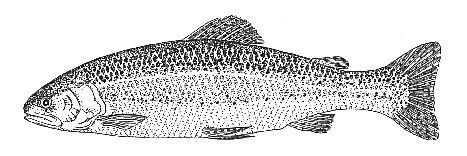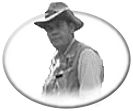Do Rainbow
Trout have a 'preference' for one food item on the aquatic menu over
something else? You're darn right they do. At the best of times the
trout are fussy about what and when they eat. Even when they are feeding,
they seem to have some form of communal communication that allows
them to determine "OK everybody, lets eat Chironomid this afternoon".
These
communal feeding habits tend to indicate that there is a systematic
logic as to how the trout feed. There seems to be more to it than
just "Oh, there is a Chironomid and I think I shall eat it". The trout,
as a group, seem to have a definite 'preference' for one food item
over another. Sure, there will be an occasional trout that varies
from the communal norm but feeding is fairly consistent throughout
the trout population in a lake.
I have
been looking for, and think I have found 'some' of the rules governing
feeding among the Rainbow Trout. The food of choice will vary with
the season, time of day, and various environmental conditions conducive
to feeding on that food source.

Rainbow Trout
Seasonal
Food Preferences
That
old saying "Match the Hatch" may be responsible for more fish
NOT being caught than any other factor in the selection of
what fly to use. Many fly fishers will think I'm being Sacrilegious
by questioning this most basic statement from the Gods of Fly-Fishing.
"Match the Hatch" isn't totally wrong as much as it isn't totally
correct. This is because Rainbow Trout 'prefer' certain foods at certain
times and that preference may not be the main hatch being observed.
A more
correct statement would be to "Match the NEW Hatch".
Trout prefer food items that are just becoming available during the
season. Trout feeding throughout May, for example, will have already
gorged themselves on Chironomid
hatches. The trout then go into a 'non-feeding' cycle to digest their
food. When the trout are ready to resume feeding, they probably don't
want to see or eat another Chironomid. After a full diet of Chironomid,
the trout will "prefer" another, any other, food source. When Caddis,
Damsels,
or another food source FIRST becomes available in June, it
will be the food of choice even though there may be many Chironomids
still available and hatching. Naturally, if these other food sources
are not available the trout will try a smaller new food or even revert
back to the Chironomid.
Also,
the trout will generally pick the larger of two new items on the menu.
If two hatches of Chironomid are just starting, and one species is
significantly larger than the other, it will probably be the preferred
food even though substantially fewer individuals are hatching. The
fly fisher can take advantage of this knowledge.
Daily
Food Preference
One of
the most profound examples of preference is to watch a 'feeding change'
that occurs within a short period of time. I have watched trout switch
from Chironomid to Caddis, for example, within an hour. The fish were
actively feeding on Chironomid in the morning. At 11:00am, the bite
stopped, at 11:30 I saw a single Caddis emerge, and by noon I was
into better fishing than the morning hours with a Caddis pupa. Virtually
every fish in the lake had switched from abundantly available Chironomid
to the scarce Caddis.
All the
fish seemed to know that Caddis were going to be available and all
agreed that they were to be the afternoon food of choice. Bugs often
hatch according to water temperature, sun-angle, and hours of daylight.
Trout seem to know when conditions are right for certain hatches.
In this case it was almost as if the morning Chironomid feed was just
an appetizer before the main course.
There
is also a preference for certain aquatic bugs at certain times of
the day. Often this is because of availability. For example, dragonfly
hatches occur at night and the trout are most likely to feed on them
at that time. However, damselfly hatches occur in the afternoon and
that is the prime time for feeding on those. The time of day is an
important consideration for the fly fisher trying to determine what
fly is likely to be best. But again, the beginning of a hatch is far
better than the middle. And the middle of a hatch is far better than
the end.
Environmental
Limiting Factors
Environmental
factors affect the trout's preference for a newly available food source.
When conditions are right they will be 'right on' a new food source.
If conditions are wrong, they will wait until conditions are more
favorable to feed on their food of choice.
For example,
bright sunlight with calm conditions will drive trout into deeper
waters. The fish will leave the shallows even though a new hatch may
be just beginning. The fish will then wait to feed or they may seek
a preferred food available within the deeper waters. If a breeze picks
up and the light levels drop the trout will move back to the shallows
and resume feeding on what they had earlier left. Either way, it will
still be something they haven't been consuming in vast quantities
over the last little while. Trout will sometimes risk unfavorable
conditions to get a preferred food but it is not the general rule-of-thumb.
Also, it is usually the smaller fish that take these risks.
Fishing
Tips




